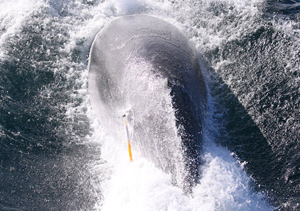Japanese Whalers Kill 333 Minke Whales, Many Pregnant
The Japanese whaling fleet has returned home after killing 333 minke whales in the Southern Ocean.
Of the 333 whales killed, there were 186 males and 147 females. Just over 50 percent of the females were adult, and preliminary analysis, such as pregnancy rates, suggest healthy fertility of the species, says Japan's Institute of Cetacean Research.
Of the previous season's killing of 333 minke whales, 181 were females, and 122 of these were pregnant.
Japan says the purpose of the five-vessel survey is to improve understanding of the species and regional ecology so that it can calculate capture limits.
The whales were hunted between December 18, 2018 and February 27, 2019, and the survey area was the sea area south of 60 degrees south between 0 degree longitude and 115 degree longitude.
The mother ship Nisshin Maru sailed under the leadership of Captain Eguchi Koji. The other vessels were sailed under the leadership of Captain Kasai Nishi, Captain Okoshi, Captain Abe and Captain Saki Yasu. Overall, 175 people were involved in the expedition.
 The survey included visual, lethal and non-lethal research. The most frequently found whale species were humpback whales (1,586 in 1,004 groups), followed by black minke whales (866 in 514 groups), fin whales (658 in 291 groups), killer whales (187 in 16 groups) and sperm whales (93 in 93 groups).
The survey included visual, lethal and non-lethal research. The most frequently found whale species were humpback whales (1,586 in 1,004 groups), followed by black minke whales (866 in 514 groups), fin whales (658 in 291 groups), killer whales (187 in 16 groups) and sperm whales (93 in 93 groups).
Last year, the Government of Japan left the International Whaling Commission and announced that it will cease whaling in the Southern Ocean after this season. However, Japan will continue with commercial whaling in its coastal waters, joining Norway and Iceland as whaling nations in the North Pacific and the North Atlantic.
A spokesperson for this last Southern Ocean expedition noted: “In this term, I was able to concentrate on the investigation without being disturbed by the anti-whaling organizations.”
Sea Shepherd has opposed Japanese whaling in the Southern Ocean every year from 2005 to 2017 except for the 2014/2015 season when the whalers did not return to Antarctic waters. Sea Shepherd sent two ships down to the Southern Ocean in the 2016/2017 season but could not close in because of advanced military satellite technology that allowed the whalers to see Sea Shepherd's movements in real time.

that matters most
Get the latest maritime news delivered to your inbox daily.
The organization did not return for the 2017/2018 whaling operation “because it would be like taking a slingshot to a gunfight in pursuit of whalers who can see us but we can’t see them - in other words, a fruitless waste of time and resources,” said founder Paul Watson.
Noting the 333 whales killed this season, Australian environmentalist Bob Brown said: “It is a tribute to the millions who have backed Sea Shepherd’s courageous peaceful obstruction of the Japanese slaughter of whales in recent years that this needless and illegal slaughter has been brought to an end. Japan’s ongoing whale killing in the North Pacific will now be the focus of global revulsion until that barbaric spectacle is also brought to an end once and for all,” Brown said.
